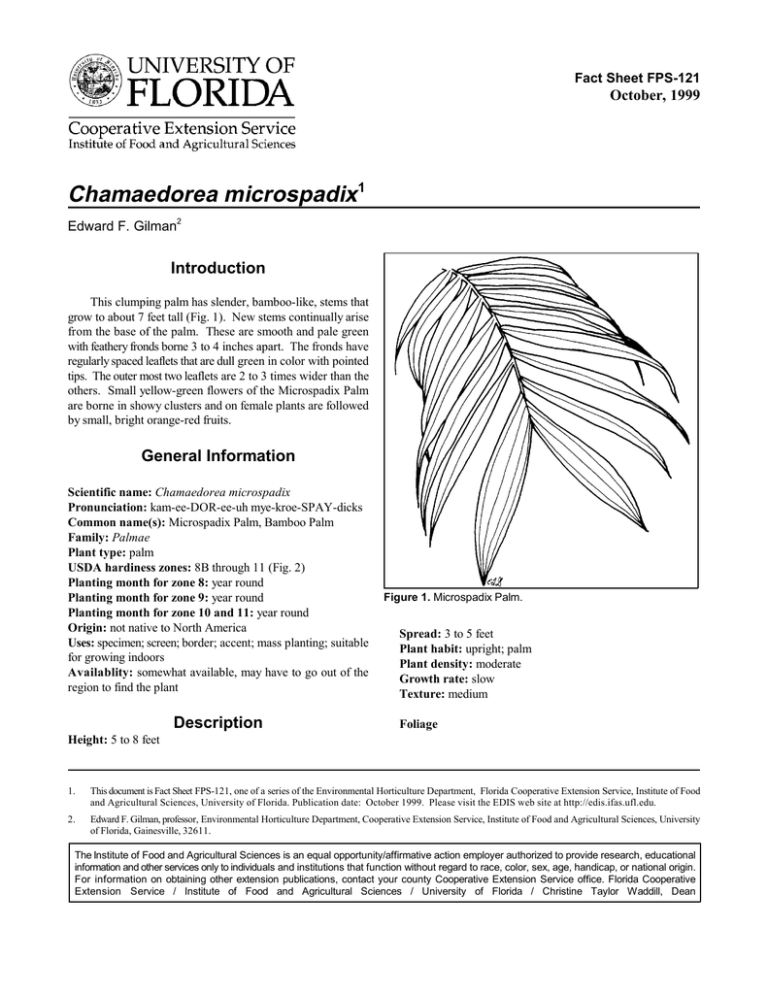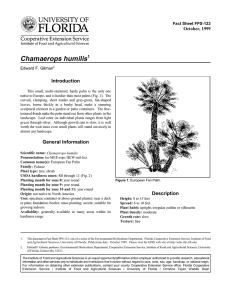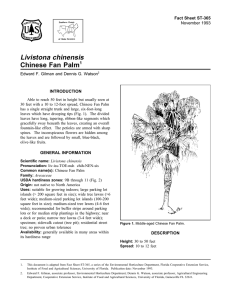Chamaedorea microspadix Introduction October, 1999 Fact Sheet FPS-121
advertisement

Fact Sheet FPS-121 October, 1999 Chamaedorea microspadix1 Edward F. Gilman2 Introduction This clumping palm has slender, bamboo-like, stems that grow to about 7 feet tall (Fig. 1). New stems continually arise from the base of the palm. These are smooth and pale green with feathery fronds borne 3 to 4 inches apart. The fronds have regularly spaced leaflets that are dull green in color with pointed tips. The outer most two leaflets are 2 to 3 times wider than the others. Small yellow-green flowers of the Microspadix Palm are borne in showy clusters and on female plants are followed by small, bright orange-red fruits. General Information Scientific name: Chamaedorea microspadix Pronunciation: kam-ee-DOR-ee-uh mye-kroe-SPAY-dicks Common name(s): Microspadix Palm, Bamboo Palm Family: Palmae Plant type: palm USDA hardiness zones: 8B through 11 (Fig. 2) Planting month for zone 8: year round Planting month for zone 9: year round Planting month for zone 10 and 11: year round Origin: not native to North America Uses: specimen; screen; border; accent; mass planting; suitable for growing indoors Availablity: somewhat available, may have to go out of the region to find the plant Description Figure 1. Microspadix Palm. Spread: 3 to 5 feet Plant habit: upright; palm Plant density: moderate Growth rate: slow Texture: medium Foliage Height: 5 to 8 feet 1. This document is Fact Sheet FPS-121, one of a series of the Environmental Horticulture Department, Florida Cooperative Extension Service, Institute of Food and Agricultural Sciences, University of Florida. Publication date: October 1999. Please visit the EDIS web site at http://edis.ifas.ufl.edu. 2. Edward F. Gilman, professor, Environmental Horticulture Department, Cooperative Extension Service, Institute of Food and Agricultural Sciences, University of Florida, Gainesville, 32611. The Institute of Food and Agricultural Sciences is an equal opportunity/affirmative action employer authorized to provide research, educational information and other services only to individuals and institutions that function without regard to race, color, sex, age, handicap, or national origin. For information on obtaining other extension publications, contact your county Cooperative Extension Service office. Florida Cooperative Extension Service / Institute of Food and Agricultural Sciences / University of Florida / Christine Taylor Waddill, Dean Chamaedorea microspadix -- Microspadix Palm Page 2 Figure 2. Shaded area represents potential planting range. Leaf arrangement: spiral Leaf type: even-pinnately compound Leaf margin: entire Leaf shape: lanceolate Leaf venation: parallel Leaf type and persistence: evergreen Leaf blade length: 4 to 8 inches Leaf color: green Fall color: no fall color change Fall characteristic: not showy Flower Flower color: yellow Flower characteristic: flowers periodically throughout the year Fruit Fruit shape: round Fruit length: less than .5 inch Fruit cover: fleshy Fruit color: red Fruit characteristic: persists on the plant Trunk/bark/branches: typically multi-trunked or clumping stems; showy Current year stem/twig color: green Current year stem/twig thickness: not applicable Culture Light requirement: plant grows in the shade Soil tolerances: acidic; slightly alkaline; sand; loam; clay; Drought tolerance: moderate Soil salt tolerances: poor Plant spacing: 36 to 60 inches Other Roots: sprouts from roots or lower trunk Winter interest: no special winter interest Outstanding plant: not particularly outstanding Invasive potential: not known to be invasive Pest resistance: long-term health usually not affected by pests Trunk and Branches October 1999 Chamaedorea microspadix -- Microspadix Palm Page 3 Use and Management The Microspadix Palm makes a great border or specimen plant and is quite striking when planted in mass. It is also a wonderful container plant for outdoor or indoor decoration. It can be grown inside in a bright location. Old fronds turn brown and hang on the plant for a considerable length of time. The plant looks much neater when these are regularly removed. This excellent garden palm tolerates high shade. Plants can be acclimated to a partially sunny location with gradual exposure. However, plants receiving regular fertilizer applications appear much greener and more attractive than those without fertilizer. Regular irrigation also appears to encourage continued growth. The Microspadix Palm will do well in a partially to fully shaded location in the landscape. It is tolerant of short periods of drought and will be happy in most well-drained soils. Pests and Diseases No pests or diseases are of major concern. October 1999






